
All news for October 2008
-
FEATURE Gamma-ray Bursts: The Mystery Continues, ESA, Science & technology (Oct 31, 2008)
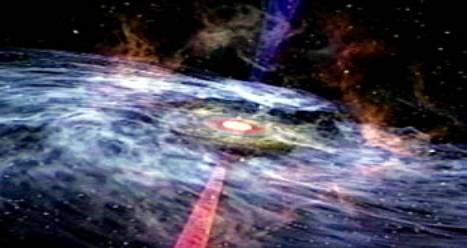 October
16, 2008: People of the 'Deep South' love a good
story and they're about to get a doozy. It begins next week
when researchers from 25 countries converge on Huntsville,
Alabama, to share the latest findings on the biggest explosions
since the Big Bang itself. The 6 th Huntsville Gamma-ray Burst
Symposium 2008 convenes Oct. 20th and the talking won't stop...
October
16, 2008: People of the 'Deep South' love a good
story and they're about to get a doozy. It begins next week
when researchers from 25 countries converge on Huntsville,
Alabama, to share the latest findings on the biggest explosions
since the Big Bang itself. The 6 th Huntsville Gamma-ray Burst
Symposium 2008 convenes Oct. 20th and the talking won't stop...
-
NASA Fermi Telescope Discovers First Gamma-Ray-Only Pulsar, NASA (Oct 31, 2008)
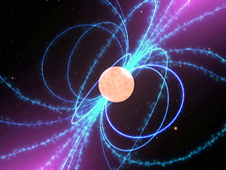 Clouds of charged particles move along
the pulsar's magnetic field lines (blue) and create a lighthouse-like
beam of gamma rays (purple) in this illustration.
Credit: NASA
WASHINGTON -- About three times a second, a 10,000-year-old stellar
corpse sweeps a beam of gamma-rays toward Earth. Discovered by...
Clouds of charged particles move along
the pulsar's magnetic field lines (blue) and create a lighthouse-like
beam of gamma rays (purple) in this illustration.
Credit: NASA
WASHINGTON -- About three times a second, a 10,000-year-old stellar
corpse sweeps a beam of gamma-rays toward Earth. Discovered by...
-
INTEGRAL confirms distinct, low-luminosity population of gamma-ray bursts, ESA, Science & technology (Oct 31, 2008)
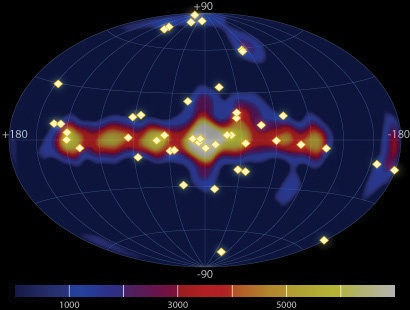 An analysis of the 47 gamma-ray bursts detected by INTEGRAL since
its launch reveals a previously unnoticed population of faint gamma-ray
bursts associated with the local supergalactic structure.
This result is reported by Suzanne Foley and colleagues in the June 2008 issue of Astronomy & Astrophysics....
An analysis of the 47 gamma-ray bursts detected by INTEGRAL since
its launch reveals a previously unnoticed population of faint gamma-ray
bursts associated with the local supergalactic structure.
This result is reported by Suzanne Foley and colleagues in the June 2008 issue of Astronomy & Astrophysics....
-
Magnetic Portals Connect Sun and Earth, NASA (Oct 30, 2008)
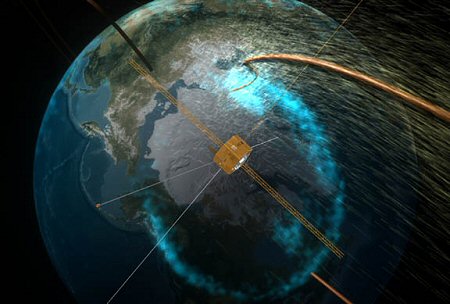 Oct.
30, 2008: During the time it takes you to read this
article, something will happen high overhead that until recently
many scientists didn't believe in. A magnetic portal will
open, linking Earth to the sun 93 million miles away. Tons
of high-energy particles may flow through the opening before
it closes again, around the time you reach the end of the
page....
Oct.
30, 2008: During the time it takes you to read this
article, something will happen high overhead that until recently
many scientists didn't believe in. A magnetic portal will
open, linking Earth to the sun 93 million miles away. Tons
of high-energy particles may flow through the opening before
it closes again, around the time you reach the end of the
page....
-
One Broke, the Other Lost, Lenta.ru (Oct 20, 2008)
 Астронавт на механическом манипуляторе готовится к "высадке" на телескоп "Хаббл" для выполнения ремонтных работ. Фото NASA
Один сломал, другой потерял
Ремонт телескопа "Хаббл" отложили из-за очередной поломки
Все, что может испортиться, портится.
Все, что не может испортиться,...
Астронавт на механическом манипуляторе готовится к "высадке" на телескоп "Хаббл" для выполнения ремонтных работ. Фото NASA
Один сломал, другой потерял
Ремонт телескопа "Хаббл" отложили из-за очередной поломки
Все, что может испортиться, портится.
Все, что не может испортиться,...
-
A MSU Alumnus Criticizes Auger Group Conclusions, ГРАНИ.Ру (Oct 20, 2008)
 Выпускник МГУ критикует выводы группы Оже
Связь UHECRs с AGN (радиогалактика Центавр A). Изображение из статьи Moskalenko et al.
Группа американских исследователей, возглавляемая выпускником Физического факультета МГУ Игорем Москаленко из Стэнфордского университета ( Stanford University ,...
Выпускник МГУ критикует выводы группы Оже
Связь UHECRs с AGN (радиогалактика Центавр A). Изображение из статьи Moskalenko et al.
Группа американских исследователей, возглавляемая выпускником Физического факультета МГУ Игорем Москаленко из Стэнфордского университета ( Stanford University ,...
-
How Round is the Sun?, NASA (Oct 20, 2008)
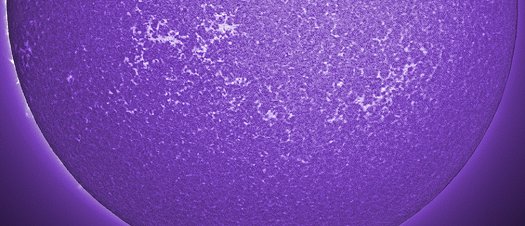 Oct.
2, 2008: Scientists using NASA's RHESSI spacecraft
have measured the roundness of the sun with unprecedented
precision, and they find that it is not a perfect sphere.
During years of high solar activity the sun develops a thin
"cantaloupe skin" that significantly increases its
apparent oblateness. Their results appear the Oct. 2nd edition
of Science...
Oct.
2, 2008: Scientists using NASA's RHESSI spacecraft
have measured the roundness of the sun with unprecedented
precision, and they find that it is not a perfect sphere.
During years of high solar activity the sun develops a thin
"cantaloupe skin" that significantly increases its
apparent oblateness. Their results appear the Oct. 2nd edition
of Science...
-
When it comes to galaxies, diversity is everywhere [heic0819], ESA, Science & technology (Oct 20, 2008)
 30 Sep 2008
A group of galaxies in our cosmic backyard has
given astronomers clues about how stars form. A thorough survey using
the NASA/ESA Hubble Space Telescope has observed around 14 million
stars in 69 galaxies. Some galaxies were found to be full of ancient
stars, while others are like sun-making factories.
The detailed study, called the ACS Nearby Galaxy...
30 Sep 2008
A group of galaxies in our cosmic backyard has
given astronomers clues about how stars form. A thorough survey using
the NASA/ESA Hubble Space Telescope has observed around 14 million
stars in 69 galaxies. Some galaxies were found to be full of ancient
stars, while others are like sun-making factories.
The detailed study, called the ACS Nearby Galaxy...
-
CERN will Open Computing system of the Big Hadronic Collider, Lenta.ru (Oct 20, 2008)
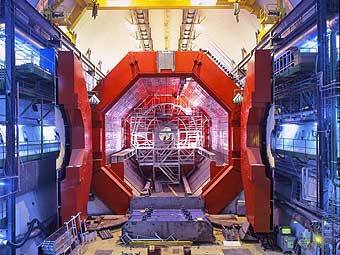 Один из детекторов коллайдера, данные с которого будут обрабатываться новой системой GRID. Фото CERN
CERN откроет вычислительную систему Большого адронного коллайдера
Третьего октября состоится открытие системы распределенных вычислений
Большого адронного коллайдера (БАК) GRID. Об этом...
Один из детекторов коллайдера, данные с которого будут обрабатываться новой системой GRID. Фото CERN
CERN откроет вычислительную систему Большого адронного коллайдера
Третьего октября состоится открытие системы распределенных вычислений
Большого адронного коллайдера (БАК) GRID. Об этом...
-
Scientists Have Discovered a Galaxy with Immensely Strong Magnetic Field (Oct 20, 2008)
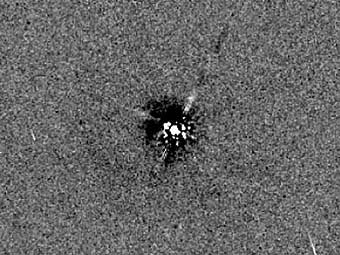 Изображение галактики DLA-3C286, полученное с помощью радиотелескопа. Фото H-W Chen/University of Chicago
Ученые обнаружили галактику с необычайно сильным магнитным полем Астрономы обнаружили молодую галактику с необычайно сильным магнитным
полем. Об этом сообщает New Scientist. Работа...
Изображение галактики DLA-3C286, полученное с помощью радиотелескопа. Фото H-W Chen/University of Chicago
Ученые обнаружили галактику с необычайно сильным магнитным полем Астрономы обнаружили молодую галактику с необычайно сильным магнитным
полем. Об этом сообщает New Scientist. Работа...
-
The Brightest Explosion of the Universe, Газета.Ru (Oct 20, 2008)
 Самый яркий взрыв Вселенной
В марте на небе можно
было невооружённым глазом увидеть один из самых мощных взрывов во
Вселенной, произошедший 7,5 миллиарда лет назад. Записать его на видео
смог российско-итальянский мониторинговый телескоп TORTORA и его
польский "коллега" Pi of the Sky. Анализ данных показывает, что Земля в
тот момент встала на пути...
Самый яркий взрыв Вселенной
В марте на небе можно
было невооружённым глазом увидеть один из самых мощных взрывов во
Вселенной, произошедший 7,5 миллиарда лет назад. Записать его на видео
смог российско-итальянский мониторинговый телескоп TORTORA и его
польский "коллега" Pi of the Sky. Анализ данных показывает, что Земля в
тот момент встала на пути...
-
Solar Barometer, is the Storm Inevitable?, akado.com (Oct 20, 2008)
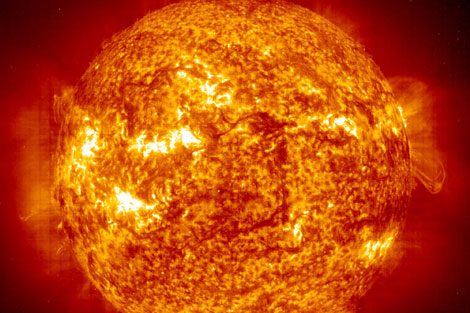 Фото: Reuters
Солнечный барометр: буря неизбежна?
12 сентября, 18:16 |
Александр Загнетко
Рубрики: , космос
Все
больше появляется свидетельств в пользу того, что предстоящие несколько
лет могут ознаменоваться множеством аварий и катастроф, связанных...
Фото: Reuters
Солнечный барометр: буря неизбежна?
12 сентября, 18:16 |
Александр Загнетко
Рубрики: , космос
Все
больше появляется свидетельств в пользу того, что предстоящие несколько
лет могут ознаменоваться множеством аварий и катастроф, связанных...
-
Not Only Mice, Lenta.ru (Oct 19, 2008)
 Лабораторные мыши Microsoft Hardware
Не только мыши
Microsoft пустила журналистов в свои лаборатории и показала технологии будущего
9 и 10 сентября на мероприятии Hardware Anywhere в
Сиэтле корпорация Miсrosoft представила с десяток новых продуктов,
выход которых состоится осенью. В их числе...
Лабораторные мыши Microsoft Hardware
Не только мыши
Microsoft пустила журналистов в свои лаборатории и показала технологии будущего
9 и 10 сентября на мероприятии Hardware Anywhere в
Сиэтле корпорация Miсrosoft представила с десяток новых продуктов,
выход которых состоится осенью. В их числе...
-
International workshop in Armenia: “Forecasting of Radiation and Geomagnetic Storms by networks... (Oct 3, 2008)
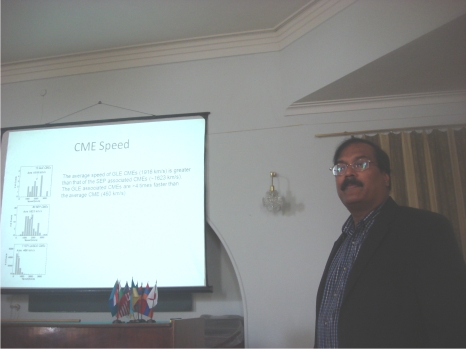 Summary and recommendations
The International
Workshop: “Forecasting of Radiation and
Geomagnetic Storms by networks of particle detectors” (FORGES-2008) was held on
September 29 - October3, 2008, in International Conference Center, Nor Amberd,
Armenia, 40 km from Armenia's capital Yerevan. The focus of the Symposium was
pointed on the Space...
Summary and recommendations
The International
Workshop: “Forecasting of Radiation and
Geomagnetic Storms by networks of particle detectors” (FORGES-2008) was held on
September 29 - October3, 2008, in International Conference Center, Nor Amberd,
Armenia, 40 km from Armenia's capital Yerevan. The focus of the Symposium was
pointed on the Space...
